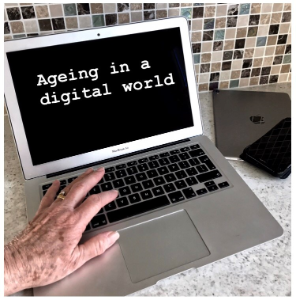Healthy ageing
Technology as a tool for social connection

Research aim: This study set out to explore older people’s experiences of using technology, including social media, to connect with others. We sought to understand the motivations and preferences for using technology to connect with others, as well as what helped and hindered the use of technology. Additionally, we aimed to explore the relationship between loneliness, social isolation and technology use.
Relevance: Loneliness and social isolation are recognised as being linked to poor physical health and wellbeing. Digital devices and social media can aid communication however, there is limited evidence of its use with older people. Despite levels of technology use rising over the past decade for users of all ages, figures show that older adults are narrower in their use of the internet and are less likely to carry out a wide range of tasks online. Digital exclusion has the potential to exacerbate isolation, as keeping in touch with friends and family is often viewed as one of the most important parts of being online. It was therefore important to study older adults’ use of technology to connect with others, and its relationship to loneliness and social isolation.
Research summary: This research was designed as a mixed-methods (combining quantitative and qualitative data collection), two-phase study. Phase one involved interviewing 20 adults, aged 65-years-or-older, from across the UK, who regularly used digital devices and social media. The resulting themes informed phase two, a national online survey which was completed by 410 older adults.
Findings: Participants primarily used technology for ‘meaningful’ online relationships with their existing network of family and friends, and specifically connecting with those living abroad or at a distance. Visual communication tools, such as Skype and WhatsApp, emerged as the preferred method of achieving these meaningful relationships. While no form of technology can replace face-to-face interactions, visual communication was considered the ‘next best’ option, and the participants discussed the importance of being able to see others.
All of the participants were regular technology users, yet they still experienced barriers to using it as a tool to connect with others. These barriers included low confidence, a lack of patience when using technology, as well as concerns around privacy, and a fear of breaking the device or ‘doing something wrong’. For a number of participants, physical ailments also caused problems when using devices, particularly relating to eyesight and persistent pain. Finally, it was also evident that existing social groups and relationships were a key factor in participants choosing to use technology and for ongoing support.
The overall message from this research study was that technology can be used as a tool for social connection, but is not a replacement for face-to-face communication. Physical, psychological, and social barriers impact upon the use of technology for social connection - even for those who use it on a regular basis.
The wider research team: Mrs Jessica Gates (Northumbria University), Dr Santosh Vijaykumar (Northumbria University) and Dr Deborah Morgan (Swansea University).
Funding details: This study, funded by the British Academy/Leverhulme Trust, ran from March 2019 to February 2020.
Please check out the following links if you would like to read/hear more about this project:
- Article: Understanding older adults’ use of social technology and the factors influencing use
- Podcast: Ageing in a digital world
Last modified: Wed, 08 Dec 2021 15:08:15 GMT





